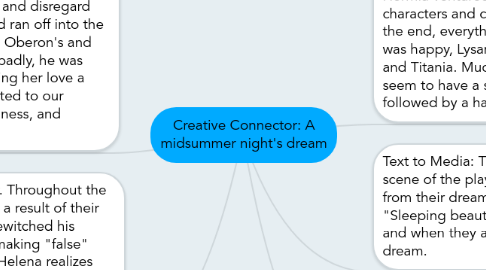Creative Connector: A midsummer night's dream
von Alexandra Balla

1. Text to World: The conflicts throughout the play are mostly caused by the will of a certain personage within the play. An example is Hermia and Lysander, the two lovers faced a conflict with Hermia's father, who was very possessive of his daughter. Hermia's father would only approve of the man the he, himself wanted his daughter to marry. Because of Egeus' selfish ways and disregard of other people's wills, and feelings, Hermia and Lysander had ran off into the woods, resulting in a problematic setting. Another example is Oberon's and Titania's situation. Oberon wanted to raise the Indian boy so badly, he was even willing to do something so vile, to rid of Titania, by making her love a "monster" to get his own way. I do believe that this is connected to our everyday lives, as I often witness "evil acts" come from selfishness, and people wanting things to be their own way.
2. Text to Media: Love is a grand theme within the play, and is often portrayed as something very powerful. Throughout the play characters are often found trying to gain the affection of others, either through force, writing poems, following them around and etc. these characters often face heartbreak. Other pairs of lovers are often found going far for their significant other. When Lysander was missing in the forest, Hermia ventured out alone to find him. Near the middle of the play, characters and couples were torn between love and hate, however in the end, everything somehow stood in it's proper place, everyone was happy, Lysander with Hermia, Demetrius with Helena, Oberon and Titania. Much like many movies and books about love, they all seem to have a similar plot, with the similar problematic setting followed by a happy ending.
3. Text to World: The play is more dream oriented rather than reality. Throughout the play, the characters were often led to say and do certain things as a result of their emotions. When Egeus was telling Oberon how Lysander had bewitched his daughters heart. As the readers, we know that it is simply Egeus making "false" fantasy excuses, to justify his reasoning for hating Lysander. Like Helena realizes that love blinds you, when she argues that love can make the vile beautiful. I think this relates to society, and our world today because it is often that you see people blinded by their emotions, into making wrong uneducated decisions, and often into over-exaggerating a certain scenario.
4. Text to Media: The movie "Sleeping beauty" is somewhat relevant to the last scene of the play. The last scene consists mainly of all the characters waking up from their dreamy state that the fairy king had put upon them. In the movie "Sleeping beauty" the fairies put a spell on the village to make everyone sleep, and when they all wake up, events from past nights seem to only be part of a dream.
5. Text to Media: Tinkerbell, from Peter Pan, is similar to the personage of Puck, both are mischievous fairies who are entertained by pranking other people. The two characters both have 'masters', Puck has Oberon like Tinkerbell has Peter Pan. Tinkerbell, just like Puck would do anything that her 'master' tells her, even if she doesn't necessarily agree with him.


